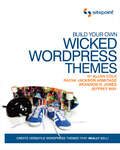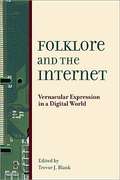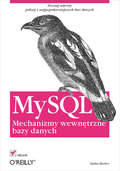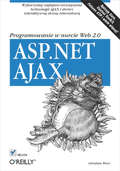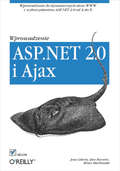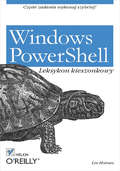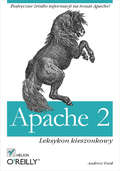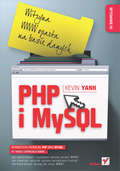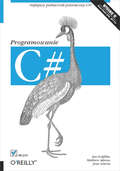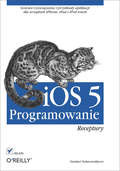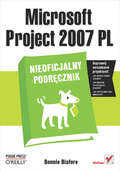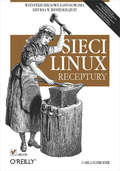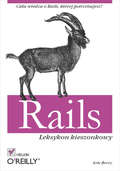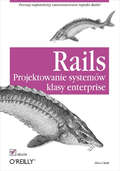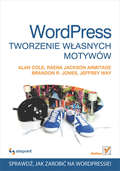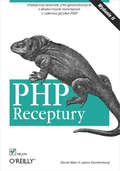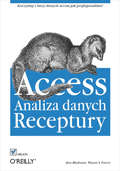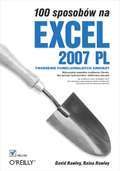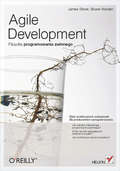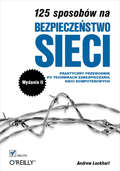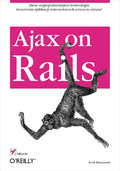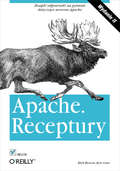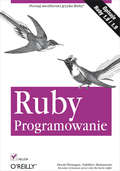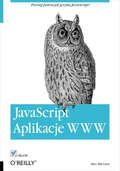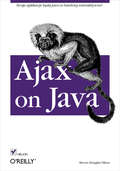- Table View
- List View
Build Your Own Wicked Wordpress Themes: Create Versatile Wordpress Themes That Really Sell!
by Alan Cole Raena Jackson Armitage Brandon R. Jones Jeffrey WayWicked WordPress Themes is a step-by-step guide to creating beautiful themes for the world's most popular CMS, WordPress.By following the book's advice, readers can produce designs that are aesthetically stunning, consistent, and for-purpose -whether it's for their own use, or to drive a high price on the theme marketplace.All facets of theme design are covered: from design, coding, and deployment, to ensuring readers' designs are ready-to-go as soon as they're installed. Wicked WordPress Themes teaches readers how to leverage theme design frameworks to dramatically shorten development time, enabling them to enter the theme market faster.
Folklore and the Internet
by Trevor J. BlankA pioneering examination of the folkloric qualities of the World Wide Web, e-mail, and related digital media. These stuidies show that folk culture, sustained by a new and evolving vernacular, has been a key, since the Internet's beginnings, to language, practice, and interaction online. Users of many sorts continue to develop the Internet as a significant medium for generating, transmitting, documenting, and preserving folklore. In a set of new, insightful essays, contributors Trevor J. Blank, Simon J. Bronner, Robert Dobler, Russell Frank, Gregory Hansen, Robert Glenn Howard, Lynne S. McNeill, Elizabeth Tucker, and William Westerman showcase ways the Internet both shapes and is shaped by folklore
MySQL. Mechanizmy wewn?trzne bazy danych
by Sasha PachevPoznaj sekrety jednej z najpopularniejszych baz danych Jak przechowywane sš dane? Jak dodawa? w?asne zmienne konfiguracyjne? Jak przebiega proces replikacji? MySQL to obecnie jedna z najpopularniejszych baz danych. Jednš z jej najwi?kszych zalet jest nieodp?atny dost?p zarówno do samego systemu, jak i do jego kodu ?ród?owego. Mo?liwo?? przeglšdania kodu i -- w razie potrzeby -- samodzielnego modyfikowania go mo?e okaza? si? przydatna programistom tworzšcym aplikacje, które korzystajš z MySQL jako zaplecza bazodanowego. Jednak samodzielne "przegryzanie si?" przez setki tysi?cy linii kodu i rozpracowywanie mechanizmów dzia?ania bazy danych mo?e zajš? mnóstwo czasu. Dzi?ki tej ksiš?ce poznasz kod ?ród?owy i sposób dzia?ania tego narz?dzia. Autor, przez wiele lat pracujšcy w zespole tworzšcym MySQL, przedstawia w niej tajniki systemu. Podczas czytania poznasz architektur? i wzajemne powišzania pomi?dzy komponentami MySQL, struktur? kodu ?ród?owego oraz metody modyfikowania go przez kompilacjš. Dowiesz si? tak?e, jak przebiega komunikacja pomi?dzy klientem i serwerem bazy danych, jak realizowane sš zapytania, w jaki sposób sk?adowane sš dane i jak implementowane sš mechanizmy replikacji. Architektura MySQL Struktura kodu ?ród?owego Komunikacja pomi?dzy klientem i serwerem Zmienne konfiguracyjne Obs?uga ?šda? Parser i optymalizator zapyta? Mechanizmy sk?adowania danych Replikacja danych Dzi?ki tej ksiš?ce zrozumiesz budow? bazy danych MySQL i b?dziesz w stanie samodzielnie dostosowa? jš do ka?dego zadania.
ASP.NET AJAX. Programowanie w nurcie Web 2.0
by Christian WenzWykorzystaj najlepsze rozwišzania technologii AJAX i stwórz interaktywnš stron? internetowš Jak wykorzystywa? dane serwerowe?Jak tworzy? i udost?pnia? w?asne kontrolki?Jak aktualizowa? cz??? strony w regularnych odst?pach czasu?Zastanawia?e? si?, dlaczego interaktywne witryny cieszš si? dzi? takš popularno?ciš? Dzieje si? tak g?ównie dlatego, ?e wymagajš one od u?ytkowników wspó?uczestnictwa w tworzeniu i rozwoju serwisu, a tym samym powodujš, ?e abonenci majš du?y wp?yw na jego ostateczny kszta?t. Dzi?ki temu ka?dy odbiorca korzysta z atrakcyjnej witryny idealnie dopasowanej do swoich potrzeb. To w?a?nie ASP.NET AJAX umo?liwia projektowanie profesjonalnych, interaktywnych stron WWW w duchu Web 2.0. Znawcy tematu zapewniajš, ?e AJAX jest rozwišzaniem przysz?o?ciowym w dziedzinie projektowania serwisów internetowych. O tym, jak za pomocš tej technologii wdro?y? w swoim serwisie rozwišzania zgodne z filozofiš Web 2.0, dowiesz si? w?a?nie z tego podr?cznika. W ksiš?ce "ASP.NET AJAX. Programowanie w nurcie Web 2.0" zamieszczono, oprócz teoretycznych wiadomo?ci, mnóstwo przyk?adów demonstrujšcych dzia?anie najwa?niejszych mechanizmów ?rodowiska ASP.NET AJAX. Przedstawione rozwišzania majš bardzo ogólny charakter, a zatem mo?esz szybko dostosowa? je do potrzeb w?asnej aplikacji. Korzystajšc z tego podr?cznika, nauczysz si? m.in. projektowa? w?asne kontrolki i udost?pnia? je w serwisie Toolkit, poznasz zasady korzystania ze standardowych bibliotek AJAX-a w innych ?rodowiskach (np. PHP). B?dziesz umia? zbudowa? profesjonalnš, dynamicznš stron? internetowš, bazujšcš na platformie ASP.NET AJAX.Struktura i architektura ?rodowiska ASP.NET AJAXJavaScriptRozszerzenia ASP.NET AJAXUs?ugi siecioweOd?wie?anie cz??ci strony -- obiekt UpdatePanelLokalizacja i globalizacja aplikacjiASP.NET Control ToolkitAnimacja na stronie WWWWišzanie i walidacja danychZachowania i komponentyDokumentacja klasy XMLHttpRequest i modelu DOMP?y? z nurtem nowoczesno?ci -- twórz elektryzujšce, interaktywne strony WWW!
ASP.NET 2.0 i Ajax. Wprowadzenie
by Jesse Liberty Dan HurwitzJak stworzy? stron? WWW w ASP.NET 2.0?Jak skorzysta? z dobrodziejstw technologii AJAX?Jak zapewni? bezpiecze?stwo, poprawno?? i trwa?o?? danych w ASP.NET 2.0?ASP.NET jest technologiš stworzonš przez firm? Microsoft, pozwalajšcš na tworzenie dynamicznych stron WWW. Dostarcza ona wielu kontrolek, które wspomagajš programist? w codziennych dzia?aniach i pozwalajš na znaczšce przyspieszenie prac nad projektowanš witrynš. Wykorzystanie technologii AJAX u?atwia tworzenie stron dostarczajšcych niezapomnianych wra?e? ich u?ytkownikom. ASP.NET wraz z technologiš AJAX w po?šczeniu z narz?dziami programistycznymi firmy Microsoft stanowiš wiodšce rozwišzanie na rynku aplikacji internetowych, a wsparcie potentata z Redmond gwarantuje sta?y rozwój tej platformy."ASP.NET 2.0 i Ajax. Wprowadzenie" odkrywa tajniki wykorzystania technologii AJAX oraz ASP.NET. Dzi?ki tej ksiš?ce dowiesz si?, jak tworzy? interaktywne i wydajne aplikacje WWW z wykorzystaniem j?zyka VisualBasic 2005. Jednocze?nie nauczysz si? zapewnia? bezpiecze?stwo w tworzonych aplikacjach i korzysta? z poszczególnych kontrolek. Autorzy ksiš?ki poka?š Ci metody radzenia sobie z b??dami, usterkami i wyjštkami wyst?pujšcymi w trakcie tworzenia i u?ywania strony. Na koniec ka?dego rozdzia?u Jesse, Dan i Brian sprawdzš Twojš wiedz? w krótkim quizie -- ale nie martw si?, na ko?cu ksiš?ki znajdziesz odpowiedzi na poszczególne pytania.Podstawy tworzenia stron WWWZa?o?enia i wykorzystanie technologii AJAXSposób zapisywania i odczytywania danych oraz kontrolki wspierajšce ten procesZapewnianie poprawno?ci danychDefiniowanie i wykorzystanie arkuszy stylów CSSWykorzystanie stron wzorcowychObs?uga i zasady nawigacji na stronieZapewnienie bezpiecze?stwa witrynieWykrywanie i rozwišzywanie problemów w kodzie Obs?uga wyjštkówWejd? w ?wiat dynamicznych stron WWW -- wykorzystaj najnowsze technologie ASP.NET!
Windows PowerShell. Leksykon kieszonkowy
by Lee HolmesCz?ste zadania wykonuj szybciej! Jakie polecenia i wyra?enia dost?pne sš w PowerShell?Jak zarzšdza? b??dami?Jak wykorzysta? klasy .NET oraz .COM? PowerShell powsta? w 2006 roku jako nast?pca takich interpreterów jak command.com czy te? cmd.exe, znanych z czasów systemu operacyjnego MS DOS czy te? pierwszych wyda? Windows XP. Aktualnie dost?pny jest dla nast?pujšcych platform: Windows XP SP2, Windows Vista, Windows 2003. Cechš charakterystycznš PowerShell jest logika obiektowa. Wynikiem ka?dego polecenia jest obiekt okre?lonego typu, posiadajšcy swoje metody oraz w?a?ciwo?ci, które mogš by? wykorzystane w dalszym toku przetwarzania.Dzi?ki ksiš?ce "Windows PowerShell. Leksykon kieszonkowy" poznasz j?zyk i ?rodowisko PowerShell. Dowiesz si?, w jaki sposób wydawa? polecenia, jak stosowa? operatory, instrukcje warunkowe, p?tle i wiele elementów znanych z innych j?zyków programowania. Po przeczytaniu tej ksiš?ki b?dziesz potrafi? zarzšdza? b??dami oraz ?ledzi? i debugowa? skrypty. Dodatkowo nauczysz si? stosowa? wyra?enia regularne oraz poznasz wybrane klasy .NET oraz .COM. Ca?a wiedza zostanie przekazana przez jednego z twórców PowerShella, co stanowi gwarancj? aktualno?ci, przydatno?ci i poprawno?ci omawianych tematów.Polecenia i wyra?enia w pow?oce PowerShellWykorzystanie tablicZastosowanie j?zyka XMLSposoby uruchamiania skryptówZarzšdzanie b??dami?ledzenie i debugowanie skryptówZastosowanie wyra?e? regularnychWykorzystanie zmiennych automatycznych w PowerShellKlasy .NET i ich zastosowanieKlasy .COM i ich zastosowanieSposoby formatowania ?a?cuchówOszcz?dzaj czas dzi?ki PowerShell!
Apache 2. Leksykon kieszonkowy
by Andrew Ford"Podr?czne ?ród?o informacji na temat Apache! Jak wykorzysta? mechanizm mod_rewrite? Jak kontrolowa? dost?p do zasobów? Jak stosowa? bezpieczny protokó? SSL? Apache jest jednym z najpopularniejszych serwerów HTTP. Jego zalety to niezawodno??, wydajno?? i elastyczno??. Mo?na go uruchomi? praktycznie w dowolnym systemie. Istotny jest równie? fakt, ?e Apache to rozwi?zanie ca?kowicie bezp?atne! Pierwsza oficjalna wersja tego serwera ukaza?a si? w 1995 roku. Oznaczono j? numerem 0.6.2. Po blisko pi?tnastu latach rozwi?zanie to zyska?o ogromn? rzesz? u?ytkowników. Spo?eczno?? zwi?zana z tym narz?dziem jest niezwykle ch?tna do pomocy, co niew?tpliwie stanowi jeszcze jeden niezmiernie wa?ny atut, przemawiaj?cy na korzy?? Apache. Niniejszy leksykon jest ?wietn? pozycj? dla tych osób, które mia?y ju? styczno?? z serwerem Apache lub chc? szybko opanowa? konkretne zagadnienia zwi?zane z jego konfiguracj?. Dzi?ki tej ksi??ce poznasz wszystkie dyrektywy, które mog? by? przydatne w codziennej pracy. Dowiesz si?, jak skonfigurowa? ?rodowisko serwera, oraz poznasz zasady odwzorowywania adresów URL. Ponadto nauczysz si? zapewnia? odpowiedni? kontrol? dost?pu do poszczególnych zasobów i korzysta? z takich mechanizmów, jak filtry, metadane lub procedury obs?ugi. Wiele cennych informacji, zawartych w tej por?cznej ksi??ce, sprawi, ?e codzienna praca z serwerem Apache b?dzie dla Ciebie przyjemno?ci?!Ogólne zagadnienia zwi?zane z prac? i konfiguracj? Apache Konfiguracja wirtualnych hostów (VirtualHost) Zarz?dzanie procesami Odwzorowanie adresów URL Przekszta?canie adresów z wykorzystaniem mod_rewrite Kontrola dost?pu Uwierzytelnianie z u?yciem mechanizmów HTTP Basic, HTTP Digest Zastosowanie metadanych dokumentów Manipulowanie nag?ówkami HTTP Wykorzystanie skryptów CGI Zastosowanie WebDAV U?ywanie filtrów Buforowanie tre?ci Konfiguracja i wykorzystanie bezpiecznego protoko?u SSL Logowanie zdarze?Skonfiguruj Apache zgodnie ze swoimi potrzebami!"
PHP i MySQL. Witryna WWW oparta na bazie danych. Wydanie IV
by Kevin YankWykorzystaj potencja? PHP oraz MySQL w Twoich serwisach WWW! Jak zainstalowa? i uruchomi? w?asny serwer WWW?Jak stworzy? autorski system zarzšdzania tre?ciš?Jak kontrolowa? dost?p do stron WWW?PHP i MySQL to najpopularniejszy tandem webmasterski. Ilo?? serwisów opartych na tym po?šczeniu jest nie do ogarni?cia. Skšd taka popularno??? Niezale?nie od innych zalet atutem tego rozwišzania jest prostota. Ju? kilka chwil wystarczy, ?eby rozpoczš? przygod? z profesjonalnym tworzeniem serwisów WWW. A je?eli po?wi?cisz troch? wi?cej czasu, poznasz i wykorzystasz jeszcze wi?cej mo?liwo?ci PHP i MySQL. Ale czy rzeczy proste nie mogš by? jeszcze prostsze?Mogš. Z ksiš?kš "PHP i MySQL. Witryna WWW oparta na bazie danych. Wydanie IV" b?yskawicznie przebrniesz przez proces instalacji wszystkich niezb?dnych komponentów — niezale?nie od systemu, którego u?ywasz. Autor opisuje tu sposób instalacji na platformach Windows, MacOS X oraz Linux. Po udanej instalacji napiszesz swój pierwszy skrypt, a nast?pnie przejdziesz do kolejnych, coraz bardziej zaawansowanych tematów. W?ród nich znajdziesz opisy takich zagadnie?, jak: j?zyk SQL, sk?adnia PHP, nawišzywanie po?šczenia z bazš, publikowanie tre?ci znajdujšcych si? w bazie. Ponadto zdob?dziesz wiedz? z zakresu administrowania bazš MySQL, systemów zarzšdzania tre?ciš, zarzšdzania sesjš czy te? wykorzystania wyra?e? regularnych. Ksiš?ka ta jest nieocenionš pomocš dla wszystkich osób zaczynajšcych przygod? ze stronami WWW oraz j?zykami PHP i SQL.Instalacja systemu na platformach Windows, Linux oraz MacOS XMySQL — podstawowe zagadnieniaPHP — sk?adnia, podstawowe polecenia i strukturyNawišzywanie po?šczenia z bazš danych z poziomu PHPPublikacja tre?ci zawartych w bazie MySQLZasady projektowania relacyjnej bazy danychTworzenie systemu zarzšdzania tre?cišWykorzystanie wyra?e? regularnychKontrola dost?pu do stronZarzšdzanie sesjš oraz "ciasteczkami"Zadania administracyjne w bazie MySQLTworzenie zaawansowanych zapyta? MySQLPrzechowywanie i wykorzystanie danych binarnych Twórz dynamiczne, bogate w tre?ci i ?atwe w zarzšdzaniu witryny WWW!
C#. Programowanie. Wydanie VI
by Matthew Adams Jesse Liberty Ian GriffithsNajlepszy podr?cznik po?wi?cony C#!W dzisiejszych czasach szczególnš popularno?ciš cieszš si? j?zyki programowania pozwalajšce na pisanie kodu ?atwego do przenoszenia mi?dzy platformami, poniewa? nikt nie ma czasu na pisanie kilku wersji jednej aplikacji. C# to uniwersalny j?zyk, który bez trudu spe?nia ten wymóg. Dzi?ki swej elastyczno?ci, wydajno?ci oraz mocnemu wsparciu spo?eczno?ci zdoby? on uznanie programistów. Jego wybór to strza? w dziesištk?!Ten bestsellerowy podr?cznik pozwoli Ci b?yskawicznie pozna? wszystkie niuanse j?zyka C# 4.0. Najnowsze wydanie zosta?o zaktualizowane o nowo?ci w C# oraz zawiera opis tego j?zyka i platformy .NET. W trakcie lektury nauczysz si? tworzy? skomplikowane programy przy u?yciu technik programowania obiektowego i funkcjonalnego. Ponadto sprawdzisz, jaki potencja? kryje j?zyk zapyta? LINQ oraz jak przesy?a? komunikaty za pomocš Windows Communication Foundation (WCF). Dodatkowo poznasz mo?liwo?ci C# w zakresie tworzenia aplikacji internetowych w technologii Silverlight. Nauka C# jeszcze nigdy nie by?a tak przyjemna!Pisz z?o?one programy z u?yciem technik programowania obiektowego oraz funkcjonalnegoPrzetwarzaj du?e kolekcje danych dzi?ki wbudowanym w j?zyk zapytaniom LINQKomunikuj si? przez sie? za pomocš Windows Communication Foundation (WCF)Poznaj zalety technik programowania dynamicznego, dost?pnych w C# 4.0Twórz interaktywne aplikacje Windows z Windows Presentation Foundation (WPF)Twórz bogate aplikacje internetowe z wykorzystaniem mo?liwo?ci Silverlight oraz ASP.NETWykorzystaj potencja? j?zyka C#!Ian Griffiths jest autorem kursu WPF oraz instruktorem w firmie Pluralsight, specjalizujšcej si? w prowadzeniu kursów Microsoft .NET. Pracuje tak?e jako niezale?ny konsultant. Jest wspó?autorem ksiš?ek "Windows Forms in a Nutshell", "Mastering Visual Studio .NET" oraz "Programming WPF", wydanych przez wydawnictwo O"Reilly.Matthew Adams jest kierownikiem do spraw tworzenia aplikacji w firmie Digital Healthcare Ltd. oraz autorem wielu artyku?ów i publikacji dotyczšcych znaczenia .NET w przemy?le informatycznym.Jesse Liberty jest starszym kierownikiem programu Microsoft Silverlight. Jest doskonale znany w ?rodowisku jako jeden z czo?owych ekspertów oraz autor bestsellerowych ksiš?ek, takich jak "Programming C# 3.0" (O"Reilly) oraz "ASP.NET 3.5. Programowanie" i "ASP.NET 2.0 i Ajax".
iOS 5. Programowanie. Receptury
by Vandad NahavandipoorGotowe rozwi?zania i przyk?ady aplikacji dla urz?dze? iPhone, iPad i iPod touchSzeroki wachlarz urz?dze? mobilnych Apple sprawia, ?e ?atwo jest dzi?ki nim dotrze? do wielkiej liczby u?ytkowników. Z drugiej strony stawia jednak przed programistami nowe wyzwania - ró?ne rozdzielczo?ci ekranu i ró?ne wyposa?enie urz?dze? to tylko niektóre z nich. Jak sobie poradzi? z codziennymi problemami w trakcie tworzenia aplikacji dla iOS-a?Je?eli znasz iOS SDK, dzi?ki tej ksi??ce nauczysz si? stosowa? setki technik z zakresu tworzenia oprogramowania na platformie iOS oraz pokonasz wiele uci??liwych problemów, które pojawiaj? si? podczas tworzenia aplikacji dla urz?dze? iPhone, iPad i iPod touch. Dowiesz si?, jak zaimplementowa? procedur? rozpoznawania gestów, odtwarzania plików audio i wideo oraz wybierania konkretnych kontaktów i grup z ksi??ki adresowej. Ponadto znajdziesz gotowe do wdro?enia przyk?ady, korzystaj?ce z wielow?tkowo?ci, geolokalizacji i aparatu fotograficznego. Ksi??ka ta jest idealn? pozycj? dla wszystkich osób tworz?cych oprogramowanie dla platformy iOS. Zawarte w niej przyk?ady zaoszcz?dz? Ci mnóstwo czasu. Ta inwestycja si? op?aca!U?ywanie ró?nych podej?? podczas tworzenia interfejsu u?ytkownikaTworzenie aplikacji wykorzystuj?cych informacje o bie??cym po?o?eniu urz?dzenia iOSImplementacje procedur rozpoznawania gestów Odtwarzanie plików audio i wideo oraz uzyskiwanie dost?pu do biblioteki wbudowanej aplikacji MuzykaPobieranie poszczególnych kontaktów i grup kontaktów z ksi??ki adresowejOkre?lanie dost?pno?ci kamery w urz?dzeniu iOS oraz uzyskiwanie dost?pu do biblioteki wbudowanej aplikacji Zdj?ciaTworzenie aplikacji wykorzystuj?cych mo?liwo?? wielozadaniowo?ci systemu iOSStosowanie i obs?uga trwa?ego magazynu danych w aplikacjachU?ywanie struktury Event Kit do zarz?dzania kalendarzami i wydarzeniamiWykorzystanie mo?liwo?ci oferowanych przez struktur? Core GraphicsUzyskiwanie dost?pu do informacji pochodz?cych z przy?pieszeniomierza i ?yroskopuWykorzystanie mo?liwo?ci oferowanych przez us?ug? iCloudZaoszcz?d? czasu dzi?ki pomocnym przyk?adom!
Microsoft Project 2007 PL. Nieoficjalny podr?cznik
by Bonnie BiaforeJak okre?li? bud?et projektu?Jak stworzy? harmonogram projektu?Jak monitorowa? jego wykonanie? Czy zd??ysz przeczyta? t? ksi??k? do ko?ca przysz?ego tygodnia? Czy zd??ysz w tym czasie rozwi?za? nagl?cy problem? Czy projekt, który realizujesz, nie przekroczy bud?etu? Czy aby na pewno twoi wspó?pracownicy ko?cz? swoje zadania zgodnie z harmonogramem? Na te i wiele innych pyta? ci??ko jest odpowiedzie? bez czasoch?onnych analiz. A i tak ka?da odpowied? z pewno?ci? b?dzie obarczona jakim? b??dem. Istnieje jednak rozwi?zanie, które pozwoli Ci zapanowa? nad skomplikowanymi projektami w sensowny i niek?opotliwy sposób. To rozwi?zanie ma posta? narz?dzia Microsoft Project 2007."Microsoft Project 2007 PL. Nieoficjalny podr?cznik" to rewelacyjna propozycja, oszcz?dzaj?ca Twój czas, odkryje przed Tob? wszystkie swoje tajemnice i da Ci do r?ki u?yteczne funkcje. Nauczysz si? planowa? projekt, a tak?e okre?la? zadania oraz czas pracy. Po przeczytaniu tej ksi??ki b?dziesz wiedzia?, jak przygotowa? plan projektu, który b?dzie przejrzysty, czytelny i - co najwa?niejsze - ?atwy w utrzymaniu, aktualizowaniu i codziennej analizie. Autor pokazuje, w jaki sposób zidentyfikowa? zasoby oraz przypisa? je do zada? oraz jak okre?li? bud?et projektu. Podczas lektury zdob?dziesz tak?e wiedz? na temat sposobów monitorowania projektu, pracy z wieloma projektami czy te? wykorzystywania danych z Microsoft Project w innych programach. Z pewno?ci? zainteresuje Ci? rozdzia? po?wi?cony szablonom i makrom, które pozwol? Ci zautomatyzowa? i przy?pieszy? cz?sto wykonywane zadania. Zarz?dzanie projektamiPlanowanie projektuIdentyfikowanie zada?Przygotowanie harmonogramu projektuTworzenie elastycznego, ?atwego do zarz?dzania harmonogramuOrganizowanie zespo?u, identyfikacja koniecznych zasobówWi?zanie zasobów z zadaniami?ledzenie wykonania harmonogramuZarz?dzanie zmianami w projekcieRaportowaniePraca z wieloma projektamiWykorzystanie makrZastosowanie szablonów Zarz?dzanie projektem mo?e by? sprawne i przyjemne!
Sieci Linux. Receptury
by Carla SchroderJak stworzy? sie? opart? o serwery pracuj?ce pod kontrol? Linuksa?Jak uruchomi? serwer VoIP i sie? VPN? Jak zapewni? bezawaryjn?, wydajn? i bezpieczn? prac? sieci?Mog?oby si? wydawa?, ?e o Linuksie napisano ju? wszystko. Jednak do tej pory nie by?o ksi??ki, która w kompleksowy sposób omawia?aby wszystkie zagadnienia, dotycz?ce spraw sieciowych w tym systemie operacyjnym. A? do teraz! Autor tej ksi??ki przedstawia poszczególne kwestie w sprawdzony w tej serii sposób: problem - rozwi?zanie - dyskusja. Dzi?ki podr?cznikowi "Sieci Linux. Receptury" dowiesz si?, w jaki sposób przygotowa? router, jak skonfigurowa? firewall przy u?yciu pakietu iptables oraz jak stworzy? punkt dost?pu do sieci bezprzewodowej i serwer VoIP, korzystaj?cy z popularnego rozwi?zania Asterisk. Poznasz zaawansowane mo?liwo?ci pakietu OpenSSH oraz sposoby bezpiecznego, zdalnego administrowania serwerem. Dodatkowo nauczysz si? u?ywa? graficznych pulpitów, ??czy? w bezpieczny sposób odleg?e sieci za pomoc? pakietu OpenVPN czy te? udost?pnia? w sieci pliki przy u?yciu serwera Samba. Twoj? ciekawo?? zaspokoi z pewno?ci? opis zastosowania Samby w roli kontrolera domeny. Po lekturze tej ksi??ki nie b?d? Ci obce sposoby monitorowania pracy sieci i us?ug, tworzenia wykresów wykorzystania zasobów czy te? u?ycia adresów IP w wersji szóstej. Jedno jest pewne: je?eli jeste? administratorem sieciowym lub masz ambicj? nim zosta?, ta ksi??ka musi znale?? si? na Twojej pó?ce!Tworzenie bramy opartej o system LinuxBudowa firewalla opartego o iptablesPrzygotowanie punktu dost?pu do sieci bezprzewodowejPrzydzielanie adresów IP za pomoc? serwera DHCPKonfiguracja serwera VoIP - AsteriskZaawansowane tematy, zwi?zane z routingiemZdalna i bezpieczna administracja z wykorzystaniem protoko?u SSHU?ywanie zdalnych pulpitów graficznychTworzenie wirtualnych sieci przy u?yciu pakietu OpenVPNWykorzystanie Linuksa w roli kontrolera domeny WindowsUdost?pnianie plików za pomoc? pakietu SambaUs?ugi katalogowe LDAPMonitorowanie i wizualizacja parametrów pracy sieci i us?ug Zastosowanie protoko?u IPv6Przygotowanie do bezobs?ugowej, sieciowej instalacji nowych systemówAdministrowanie serwerem za pomoc? konsoli pod??czonej przez port szeregowyUruchomienie serwera dial-upAnaliza, diagnoza i rozwi?zywanie problemów sieciowychOdpowiedzi na wszystkie Twoje pytania w jednym miejscu!
Rails. Leksykon kieszonkowy
by Eric BerryCa?a wiedza o Rails, której potrzebujesz! Jak zainstalowa? i skonfigurowa? Rails?Jak wykorzysta? mo?liwo?ci technologii ActiveRecord?Jak stworzy? dynamicznš aplikacj?, korzystajšc z technologii AJAX?Ruby on Rails przebojem wdar? si? na rynek szkieletów aplikacji internetowych. Stworzony w architekturze MVC, zosta? niezmiernie dobrze przyj?ty przez programistów z ca?ego ?wiata. Niewštpliwie wp?yw na ten fakt mia?y za?o?enia poczynione przez autora projektu - ?atwo?? i przyjemno?? tworzenia kodu. Powszechnie wiadomo, ?e te atuty majš niebagatelny wp?yw na szybko?? tworzenia aplikacji internetowych. Dzi?ki popularno?ci Ruby on Rails równie? znajomo?? j?zyka Ruby, pochodzšcego przecie? z Dalekiego Wschodu, staje si? powszechniejsza.W tej niezwyk?ej ksiš?ce znajdziesz odpowiedzi na wszystkie pytania, które mogš pojawi? si? w trakcie kodowania nowej aplikacji. Dowiesz si?, jak skonfigurowa? Rails, testowa? napisany kod, wykorzysta? technologi? ActiveRecord oraz przygotowa? widoki. Ponadto zdob?dziesz wiedz? na temat u?ywania technologii AJAX i REST, nauczysz si? wykorzystywa? us?ugi sieciowe oraz logowa? wa?ne informacje w trakcie pracy Twojej aplikacji. Z wiedzy tu zawartej mo?esz skorzysta? szybko i w ka?dej chwili, a co najwa?niejsze, nie b?dziesz musia? przedziera? si? przez setki niepotrzebnych stron. Tu znajdziesz tylko wiedz? niezb?dnš w Twojej pracy! Instalacja Rails Struktura plików Konfiguracja Rails Wykorzystanie skryptów Konfiguracja ?rodowiska Sposoby przeprowadzania testów w Rails U?ywanie technologii ActiveRecord Zarzšdzanie danymi w bazie Zastosowanie ActionController Tworzenie widoków Sposoby u?ycia technologii AJAX i REST w Rails Wykorzystanie us?ug sieciowych Logowanie informacji w trakcie pracy aplikacji Stosowanie metod pomocniczych Wykorzystaj Rails w Twoim projekcie szybko i przyjemnie!
Rails. Projektowanie systemów klasy enterprise
by Dan ChakPoznaj najbardziej zaawansowane tajniki Rails! Jak zorganizowa? kod, wykorzystujšc system wtyczek lub modu?y?Jakie zalety posiada architektura SOA?Jak zwi?kszy? wydajno?? Rails? Rynek szkieletów aplikacji internetowych jest niezwykle urozmaicony. W?ród wielu dost?pnych opcji mo?na znale?? tu rozwišzania przeznaczone dla projektów o ró?nej skali z?o?ono?ci, zarówno te mniej, jak i bardziej popularne. Warto jednak si?gnš? po rozwišzanie absolutnie unikatowe i wyjštkowe — Rails. Szkielet ten ?wietnie sprawdza si? zarówno w projektach ma?ych, jak i tych klasy enterprise, a ponadto znany jest ze swoich mo?liwo?ci, wydajno?ci oraz elastyczno?ci. Warto tak?e podkre?li?, ?e w pakiecie razem z nim dostaniemy licznš, ch?tnš do pomocy spo?eczno?? u?ytkowników! Autor ksiš?ki porusza interesujšce kwestie zwišzane z budowš zaawansowanych systemów informatycznych opartych o Rails. W trakcie lektury dowiesz si?, jak wykorzysta? system wtyczek jako ?rodek organizujšcy Twój kod oraz jak w tej roli sprawdzš si? modu?y. Kolejne rozdzia?y przyniosš solidny zastrzyk wiedzy na temat tworzenia rozbudowanego i bezpiecznego modelu danych, dziedziczenia wielotabelarycznego oraz wykorzystania wyzwalaczy jako narz?dzia kontroli skomplikowanych zale?no?ci w danych. Dan Chak du?y nacisk k?adzie na zagadnienia zwišzane z SOA (skrót od ang. Service Oriented Architecture) oraz wydajno?ciš. Jest to genialna pozycja dla wszystkich programistów i projektantów uczestniczšcych w projekcie wytwarzanym z wykorzystaniem Rails.Komponenty aplikacjiOrganizacja kodu z wykorzystaniem wtyczekRola modu?ów w porzšdkowaniu koduBudowa solidnego modelu danychNormalizacja modeluObs?uga danych dziedzinowychWykorzystanie wyzwalaczy w celu kontroli zale?no?ci w danychDziedziczenie jedno- i wielotabelaryczneZastosowanie modeli widokowychArchitektura SOADostarczanie us?ug typu XML-RPCUs?ugi typu RESTZwi?kszenie wydajno?ci Rails Obowišzkowa pozycja dla wszystkich programistów i projektantów korzystajšcych z Rails!
Wordpress. Tworzenie w?asnych motywów
by Alan Cole Brandon Jones Raena Jackson Armitage Jeffrey WaySprawd?, jak zarobi? na WordPressie! Jak skonstruowany jest mechanizm szablonów?Jak tworzy? motywy zgodnie z prawem?
PHP. Receptury. Wydanie II
by David Sklar Adam TrachtenbergPodr?czny s?ownik 250 sprawdzonych i skutecznych rozwišza? z zakresu j?zyka PHP Praca z typami danych i blokami programów PHP Obs?uga formularzy, baz danych i sesji Tworzenie wydajnych i bezpiecznych witryn internetowych PHP to najpopularniejszy j?zyk skryptowy na ?wiecie, wykorzystywany w milionach witryny internetowych. Szeroki wachlarz mo?liwo?ci, ?atwa sk?adnia oraz wspó?praca z wieloma systemami operacyjnymi sprawiajš, ?e jest to idealne narz?dzie do tworzenia dynamicznych aplikacji WWW. Od wersji PHP 5 j?zyk ten obs?uguje programowanie obiektowe oraz udost?pnia usprawniony mechanizm wspó?pracy z bazami danych, co w znacznym stopniu u?atwia kreowanie rozbudowanych programów sieciowych. Drugie wydanie ksiš?ki "PHP. Receptury" zawiera jeszcze wi?cej gotowych rozwišza?, które zosta?y dostosowane do nowej wersji j?zyka, czyli PHP 5. Dodatkowo ulepszona forma umo?liwia ?atwiejsze znalezienie potrzebnych receptur. Pozwolš Ci one szybko rozwišza? cz?sto spotykane problemy. Czytajšc t? ksiš?k? dowiesz si? mi?dzy innymi, jak wykonywa? operacje na ró?nych typach danych, jakie elementy sk?adajš si? na programy PHP i jak z nich korzysta?, a tak?e jak obs?ugiwa? formularze czy wspó?pracowa? z bazami danych. Nauczysz si? stosowa? techniki zarzšdzania sesjami. Poznasz zasady korzystania z XML, wspó?pracy z kodem w j?zyku JavaScript, a tak?e rozwišzania wielu innych praktycznych problemów. Praca z typami danych Korzystanie z ró?nych bloków aplikacji PHP Obs?uga formularzy Praca z bazami danych Przetwarzanie dokumentów XML Us?ugi Web Services Zarzšdzanie sesjš Generowanie grafiki na stronach internetowych Zabezpieczanie witryn Obs?uga b??dów Optymalizacja kodu Praca z systemem plików i katalogów Wykorzystaj gotowy kod do b?yskawicznego tworzenia dynamicznych witryn internetowych.
Access. Analiza danych. Receptury
by Ken Bluttman Wayne S. FreezeKorzystaj z bazy danych Access jak profesjonalista!Jak stosowa? wska?niki statystyczne do analizy danych biznesowych?Jak rozszerza? funkcjonalno?? zapyta? SQL, stosuj?c skrypty VBA? Jak przetwarza? dane i przenosi? je mi?dzy bazami Access?Access to znane ju? narz?dzie s?u??ce do wszechstronnego przetwarzania i analizy danych. Posiada sporo ukrytych mechanizmów, pozwalaj?cych efektywnie wykonywa? zadania, które pocz?tkowo mog? wydawa? si? skomplikowane. Ksi??ka przedstawia przyk?ady kwerend, metody przenoszenia danych pomi?dzy bazami Access, obliczania wielu wska?ników finansowo-biznesowych i sporo innych zagadnie? - wszystko pod k?tem analizy i przetwarzania danych. Ka?da zaprezentowana receptura jest opatrzona kompletnym opisem rozwi?zania problemu wraz ze szczegó?owym omówieniem metody post?powania oraz analiz? kodu. Access. Analiza danych. Receptury to uniwersalny podr?cznik przeznaczony zarówno dla pocz?tkuj?cych u?ytkowników bazy danych Access, jak i do?wiadczonych. Dzi?ki przejrzystemu j?zykowi i mnogo?ci poruszonych zagadnie? ka?dy, niezale?nie od stopnia zaawansowania, mo?e poszerzy? swoj? wiedz?. Zawiera mnóstwo ciekawych wskazówek i technik u?atwiaj?cych codzienn? prac? z bazami danych, co czyni j? atrakcyjn? nawet dla osób doskonale pos?uguj?cych si? baz? Access. Jest to tak?e kompendium wiedzy niezb?dnej ka?demu, kto chce wyci?ga? ze zbiorów danych naprawd? cenne informacje. Tworzenie kwerend ró?nych typówWstawianie, aktualizacja i usuwanie danychPrzetwarzanie tekstu i liczb zapisanych w formie ?a?cucha znakówZastosowanie tabel, modyfikacja zawarto?ci systemu Windows, szyfrowanie danych Wykorzystanie obiektu FileSystemObject, przetwarzanie danych XML oraz XSLT, komunikacja z bazami SQLRozwi?zywanie problemów biznesowychObliczanie wska?ników statystycznychBaza danych to fundament biznesu - zobacz, jak efektywnie ni? zarz?dza?!
100 sposobów na Excel 2007 PL. Tworzenie funkcjonalnych arkuszy
by David Hawley Raina HawleyWykorzystaj wszystkie mo?liwo?ci Excela, aby tworzy? funkcjonalne i efektowne arkuszeJak analizowa? dane i zarz?dza? nimi?Jak optymalnie wykorzystywa? tabele przestawne?Jak tworzy? spersonalizowane wykresy?Wi?kszo?? u?ytkowników Excela zna tylko drobn? cz??? dost?pnych w nim mo?liwo?ci. Istnieje jednak wiele metod pozwalaj?cych znacz?co poszerzy? wydajno?? tego programu i tworzy? efektowne arkusze kalkulacyjne bez potrzeby czasoch?onnego zdobywania wiedzy. Nowa wersja Excela umo?liwia chocia?by ?atwiejsze korzystanie z mechanizmu tabel przestawnych, formatowania warunkowego i nazw zakresów, podgl?du "na ?ywo", galerii predefiniowanych stylów oraz grafik SmartArt. Wszystko to sprawia, ?e ka?dy mo?e dzi? w swoich arkuszach u?ywa? bardziej skomplikowanych elementów wizualnych i graficznych.Obecnie, kiedy wszystko dzieje si? coraz szybciej, czas staje si? jedn? z najistotniejszych i po??danych warto?ci. Ksi??ka "100 sposobów na Excel 2007 PL. Tworzenie funkcjonalnych arkuszy" pozwala Ci w?a?nie zyska? na czasie - oferuje ponad sto gotowych metod tworzenia funkcjonalnych i efektownych arkuszy, szybkich i niezawodnych rozwi?za? skomplikowanych problemów. Warto tak?e wykorzysta? te metody do przeanalizowania oraz zastosowania niektórych mo?liwo?ci j?zyka Visual Basic for Applications (VBA) - dzi?ki temu b?dziesz móg? zaadaptowa? wszystkie zawarte tu propozycje do w?asnych potrzeb.Skoroszyty i arkuszeWbudowane mechanizmy do analizy danych i zarz?dzania nimiMetody tworzenia nazw i zakresów komórekTabele przestawneFormu?y i funkcjeWykresy i makraWspó?praca Excela z innymi aplikacjami pakietu OfficeWszystko, co chcia?by? widzie? o Excelu, aby natychmiast z niego skorzysta?. Poznaj ponad setk? sposobów skutecznego radzenia sobie z Excelem!
Agile Development. Filozofia programowania zwinnego
by James Shore ChromaticZbiór praktycznych wskazówek dla producentów oprogramowania Jak wdro?y? metodologi? programowania zwinnego?W jaki sposób zaanga?owa? klientów w projekt?Jak kontrolowa? jako?? produktów?Programowanie zwinne (Agile Development) to obecnie jedna z najpopularniejszych metodologii zarz?dzania projektami programistycznymi. Metodyka Agile jest szczególnie u?yteczna w ma?ych zespo?ach programistycznych, w których z racji u?atwionej komunikacji nie ma potrzeby tworzenia rozbudowanej dokumentacji. Programowanie zwinne opiera si? na iteracyjnej realizacji kolejnych etapów projektu. Kluczem do sukcesu w tej metodzie jest efektywna wspó?praca mi?dzy cz?onkami zespo?u projektowego.Ksi??ka "Agile Development. Filozofia programowania zwinnego" to przewodnik po programowaniu ekstremalnym, oznaczanym zwykle skrótem XP, które jest jedn? z technik wchodz?cych w sk?ad tej metodyki. Czytaj?c j?, dowiesz si?, jak wdra?a? metodologi? Agile w firmie, na czym polega programowanie ekstremalne i jak? rol? w procesie pe?ni? poszczególni cz?onkowie grupy projektowej. Nauczysz si? budowa? zespó? i okre?la? zakresy zada? osób bior?cych udzia? w pracach, planowa? harmogram udost?pniania kolejnych wersji produktu oraz kierowa? procesem jego tworzenia. Poznasz metody testowania programu i usuwania z niego b??dów, zasady pisania dokumentacji oraz regu?y prowadzenia spotka? roboczych z klientami.Wdra?anie programowania zwinnegoTechniki programowania ekstremalnegoCz?onkowie zespo?u XPZarz?dzanie zespo?emAnga?owanie klienta w proces wytwórczyTworzenie raportówUdost?pnianie kolejnych wersji systemuStandardy pisania koduTestowanie i usuwanie b??dówOptymalizacja wydajno?ci programuOd filozofii do mistrzostwa w zwinnym programowaniu!
125 sposobów na bezpiecze?stwo sieci. Wydanie II
by Andrew LockhartPraktyczny przewodnik po technikach zabezpieczania sieci komputerowych Jak sprawnie zabezpieczy? system? Jak zapewni? sobie prywatno?? w internecie? Jak skutecznie walczy? z sieciowymi w?amywaczami? W naszych domach montujemy solidne zamki i drzwi, chronimy samochody wymy?lnymi alarmami, w firmach zak?adamy systemy monitoringu, jednak nadal wiele osób nie zwraca wystarczaj?cej uwagi na bezpiecze?stwo komputerów w sieciach domowych oraz korporacyjnych. Luki w systemach informatycznych powoduj? ka?dego roku straty rz?du miliardów dolarów, a przecie? dost?pnych jest wiele narz?dzi i technik, które pozwalaj? skutecznie zabezpieczy? komputery przed atakami crackerów. "125 sposobów na bezpiecze?stwo w sieci. Wydanie II" to zaktualizowany i rozbudowany zbiór praktycznych porad dotycz?cych zabezpieczania systemów informatycznych przed atakami. Dzi?ki wskazówkom przygotowanym przez cenionych profesjonalistów dowiesz si?, jak stosowa? najnowsze narz?dzia systemowe i niezale?ne programy do zabezpieczania systemów i danych, ochrony w?asnej prywatno?ci w sieci czy bezpiecznego ??czenia zdalnych maszyn. Nauczysz si? tak?e zastawia? pu?apki na sieciowych napastników, wykrywa? ich obecno?? w sieci i szybko przywraca? normalne funkcjonowanie systemu po ewentualnym ataku. Zabezpieczanie systemów Windows i uniksowych Zapewnianie prywatno?ci w internecie Konfigurowanie i testowanie zapór sieciowych Bezpieczne korzystanie z us?ug Zabezpieczanie sieci przewodowych i bezprzewodowych Monitorowanie dzia?ania sieci Stosowanie silnego szyfrowania i uwierzytelniania Wykrywanie w?ama? i przywracanie dzia?ania sieci Stosuj sprawdzone sposoby zapewniania bezpiecze?stwa w sieci.
Ajax on Rails
by Scott RaymondZobacz, jak wykorzysta? potencja? technologii Ajax i Rails w tworzeniu zaawansowanych aplikacji internetowych! Jak u?ywa? platformy Rails do budowy dynamicznych aplikacji internetowych? Jak szybko tworzy? witryny ajaksowe, wykorzystujšc wydajne biblioteki? Jak zwi?kszy? komfort pracy u?ytkowników Twoich aplikacji internetowych? Ajax to olbrzymie mo?liwo?ci w zakresie tworzenia dynamicznych i interaktywnych aplikacji internetowych, dzia?ajšcych niemal tak szybko, jak tradycyjne programy. Jednak lepsza jako?? witryn wymaga zwykle pisania bardziej skomplikowanego kodu i, co za tym idzie, wi?kszych nak?adów pracy i czasu. Tak te? by?o do niedawna w przypadku Ajaksa, ale obecnie, gdy wzros?a popularno?? tej technologii, a ona sama dojrza?a, programi?ci mogš korzysta? z wielu bibliotek i platform, dzi?ki którym tworzenie efektownych aplikacji internetowych sta?o si? niezwykle proste. "Ajax on Rails" to podr?cznik dla programistów, którzy chcš szybko i ?atwo budowa? wydajne aplikacje internetowe na bazie dwóch popularnych mechanizmów -- technologii Ajax oraz platformy Rails. Czytajšc go, dowiesz si?, w jaki sposób Ajax umo?liwia kreowanie funkcjonalnych i wygodnych w obs?udze witryn, a tak?e nauczysz si? b?yskawicznie stosowa? t? technologi? w oparciu o biblioteki Prototype i scipt.aculo.us oraz kompletnš platform? do tworzenia aplikacji internetowych, czyli Rails. Poznasz te? sposoby sprawnego diagnozowania aplikacji ajaksowych oraz zapewnisz im bezpiecze?stwo i wydajno??, aby udost?pnia? swym klientom produkty najwy?szej klasy. Przeglšd mechanizmów technologii Ajax Dzia?anie platformy Rails Ajaksowe przesy?anie danych za pomocš biblioteki Prototype Dodawanie efektów do witryn przy u?yciu biblioteki scipt.aculo.us Generowanie kodu JavaScript za pomocš szablonów RJS Zwi?kszanie u?yteczno?ci aplikacji Diagnozowanie aplikacji na platformie Rails Zapewnianie bezpiecze?stwa programu Zwi?kszanie wydajno?ci aplikacji
Apache. Receptury. Wydanie II
by Rich Bowen Ken CoarCzy wiesz, jaki serwer HTTP jest najpopularniejszy w sieci? W?a?nie tak, jest to Apache! W lipcu 2008 roku jego udzia? w rynku wynosi? blisko 50% (wed?ug Netcraft). Historia tego serwera si?ga roku 1995, kiedy ukaza?a si? jego pierwsza oficjalna wersja, oznaczona numerem 0.6.2. Cechy, które zadecydowa?y o sukcesie tego rozwi?zania, to bezpiecze?stwo, skalowalno??, wielow?tkowo?? i obs?uga ró?norodnych j?zyków skryptowych. Dzi?ki ksi??ce "Apache. Receptury" zapoznasz si? z gotowymi przepisami na rozwi?zanie ciekawych, specyficznych oraz intryguj?cych problemów. Nauczysz si? instalowa? serwer z ró?nych ?róde? oraz na ró?nych platformach. Dowiesz si?, w jaki sposób zwi?kszy? jego bezpiecze?stwo, jak uruchomi? serwery wirtualne oraz poprawi? wydajno?? Apache. Autorzy ksi??ki poka?? Ci, jak uruchomi? obs?ug? j?zyków skryptowych, tak aby serwowane strony sta?y si? dynamiczne. Ca?a wiedza zostanie przedstawiona w sprawdzony w tej serii sposób: problem - rozwi?zanie - analiza.Sposoby instalacji serwera ApacheDodawanie funkcjonalno?ci dzi?ki modu?omMo?liwo?ci rejestracji zdarze?Konfiguracja serwerów wirtualnychWykorzystanie aliasów, przekierowa? oraz przepisa? (mod_rewrite)Zarz?dzanie dost?pem do serwowanych zasobówBezpiecze?stwo serwera ApacheWykorzystanie szyfrowanej transmisji - protokó? SSLZapewnienie wydajno?ciWykorzystanie j?zyków skryptowychOto ksi??ka z najlepszymi przepisami na Apache!
Ruby. Programowanie
by David Flanagan Yukihiro MatsumotoPoznaj mo?liwo?ci Ruby! Dlaczego Ruby zdoby? tak du?? popularno???Jak wykorzysta? wyra?enia regularne w tym j?zyku?Jak tworzy? w Ruby aplikacje sieciowe? Zaprojektowany i stworzony w 1995 roku j?zyk Ruby dzi?ki swym unikalnym mo?liwo?ciom zdobywa sobie coraz wi?ksze uznanie programistów na ca?ym ?wiecie. Jak uda?o mu si? wkupi? w ?aski tego nieufnego ?rodowiska? Przyczyni?a si? do tego mi?dzy innymi prosta sk?adnia z wbudowanymi w ni? wyra?eniami regularnymi, automatyczne oczyszczanie pami?ci i przeci??anie operatorów. Dodatkowo ogromna i ch?tna do pomocy spo?eczno?? sprawia, ?e to rozwi?zanie staje si? jeszcze bardziej atrakcyjne. Uwaga! Jednym z autorów tej ksi??ki jest sam Yukihiro Matsumoto - twórca j?zyka Ruby!Ksi??ka stanowi kompletny zbiór informacji na temat j?zyka Ruby. Je?li naprawd? chcesz zrozumie? ten j?zyk, oto obowi?zkowa pozycja do przeczytania! W trakcie lektury zapoznasz si? z bogatym API, pozwalaj?cym na przetwarzanie tekstu; zrozumiesz techniki zwi?zane z wykonywaniem dzia?a? na liczbach, implementacj? kolekcji, operacjami wej?cia-wyj?cia oraz prac? wspó?bie?n? i operacjami sieciowymi. Ponadto znajdziesz tu elementy dost?pne powszechnie w j?zykach programowania, takie jak instrukcje warunkowe, p?tle czy te? operatory logiczne. Dzi?ki ksi??ce "Ruby. Programowanie" wykorzystanie metod i obiektów klasy Proc oraz stosowanie platformy Ruby nie b?dzie stanowi?o dla Ciebie najmniejszego problemu!Wprowadzenie do j?zyka RubySposoby uruchamiania programów napisanych w RubyDost?pne typy danychZastosowanie wyra?e? i operatorówSterowanie przep?ywemWykorzystanie iteratorów oraz enumeratorówObs?uga wyj?tkówZastosowanie wspó?bie?no?ciU?ycie domkni??Cykl ?ycia obiektówRefleksje oraz metaprogramowanieLiczby w RubyU?ywanie wyra?e? regularnychKolekcjeOperacje na dacie i godzinieTablice jedno- oraz wielowymiaroweObs?uga plików oraz katalogówProgramowanie siecioweObs?uga ?rodowiska RubyGwarancja bezpiecze?stwaWykorzystaj elastyczno?? i mo?liwo?ci j?zyka Ruby!
JavaScript. Aplikacje WWW
by Alex MacCawPoznaj potencja? j?zyka JavaScript!J?zyk JavaScript od zawsze jest obecny w przegl?darkach internetowych. W swojej historii miewa? okresy lepsze i gorsze - czasem bywa? wr?cz znienawidzony przez u?ytkowników. Te czasy jednak min??y! Obecnie jego mo?liwo?ci s? wr?cz osza?amiaj?ce. Ci??ko wyobrazi? sobie wspó?czesn? popularn? aplikacj? internetow?, która nie korzysta?aby z jego dobrodziejstw. W najnowszej ods?onie HTML5 jego potencja? jest jeszcze wi?kszy!Sprawd? sam, jak wykorzysta? JavaScript do stworzenia aplikacji, która zaskoczy u?ytkowników. Budowanie w tym j?zyku du?ych internetowych aplikacji, które zaoferuj? u?ytkownikom funkcje obecne dot?d wy??cznie w aplikacjach biurkowych, wymaga utrzymywania stanu aplikacji po stronie klienta - a to nie jest ?atwe zadanie. Dzi?ki tej ksi??ce poznasz szczegó?owy opis czynno?ci, jakie trzeba wykona?, aby zaimplementowa? nowoczesn? aplikacj?, a potem opanujesz skuteczne metody korzystania z mechanizmu WebSockets, operowania na plikach oraz modelowania danych. Ponadto zg??bisz niuanse nowego API oraz dowiesz si?, jakie s? najlepsze techniki debugowania i analizowania wydajno?ci Twojej aplikacji. Ta ksi??ka to d?ugo oczekiwana pozycja, w ca?o?ci po?wi?cona zaawansowanemu wykorzystaniu j?zyka JavaScript! Z t? ksi??k? b?yskawicznie opanujesz:korzystanie z wzorca MVCobs?ug? zdarze?modelowanie danychzarz?dzanie zale?no?ciamiwykorzystywanie zewn?trznych bibliotektechniki debugowania i optymalizowania Twojego oprogramowanianajlepsze funkcje JavaScriptu!Twórz nowoczesne aplikacje przy u?yciu najlepszych dost?pnych narz?dzi!
Ajax on Java
by Steven Douglas OlsonTwoje aplikacje jeszcze bardziej interaktywne! Jak integrowa? funkcje Ajaksa z aplikacjami JSP? Jak korzysta? z dost?pnych bibliotek znaczników i tworzy? w?asne? Jak ?šczy? techniki Ajax i Struts? Technologia Ajax oparta na kodzie Java gwarantuje uzyskanie prawdziwej interaktywno?ci witryny internetowej, wysoce komfortowej zarówno dla u?ytkownika, jak i jej administratora. Wielo?? zestawów narz?dziowych i technik umo?liwia maksymalne uproszczenie i przyspieszenie pracy webmastera. Zaimplementowanie Ajaksa w aplikacjach pisanych w j?zyku Java pozwala na uzyskanie niemal wszystkich efektów potrzebnych do sprawnego funkcjonowania dynamicznej strony WWW bez konieczno?ci wykorzystywania innych technologii. Ksiš?ka "Ajax on Java" to wprowadzenie do technologii Ajax, które pokazuje, jak wzbogaca? o funkcje ajaksowe aplikacje oparte na serwletach, aplikacje JSP, JSF i inne. Dzi?ki temu podr?cznikowi nauczysz si? tworzy? bardziej interaktywne, dynamiczne i efektowne strony internetowe poprzez wyeliminowanie pracoch?onnego wpisywania danych przez u?ytkownika i irytujšcego oczekiwania na od?wie?enie strony. Poznasz równie? kilka sposobów organizowania komunikacji pomi?dzy klientem a serwerem, w tym wykorzystanie formatów JSON, umo?liwiajšcych przesy?anie danych o bardziej z?o?onej strukturze. Krótko mówišc, ksiš?ka "Ajax on Java" podniesie Twoje umiej?tno?ci programowania na wy?szy poziom. Budowanie i instalowanie aplikacji Ajax Integrowanie funkcji Ajax z aplikacjami JSP Metody tworzenia dokumentów XML Tworzenie biblioteki znaczników Pobieranie i instalowanie biblioteki Ajax Pisanie kodu JSP z wykorzystaniem Struts-Layout Konfigurowanie serwletów Wykorzystywanie zestawu narz?dziowego GWT Wyszukiwanie b??dów w kodzie aplikacji Ajax on Java -- komfort webmasterów i u?ytkowników!
